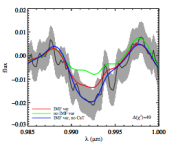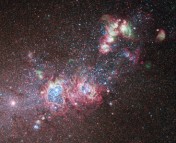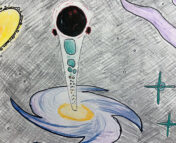Title: The Ionizing Spectra of Extremely Metal-poor O Stars: Constraints from the Only HII Region in Leo P
Authors: O. Grace Telford, Kristen B. W. McQuinn, John Chisholm, Danielle A. Berg
First Author’s Institution: Department of Physics and Astronomy, Rutgers University
Status: Published in the Astrophysical Journal [open access]
Everyone has their own definition of “metal”—maybe it’s iron, maybe it’s something that conducts electricity well, heck maybe it’s Metallica. For an astronomer, it’s any element that is not either: a. hydrogen, or b. helium. Clearly, this is a broad definition, but it’s one astronomers are really interested in. Tracing the amount of metals in stars and galaxies over different evolutionary stages tells us about how the universe evolved, since stars and supernovae fuse most of these metal atoms.
In recent years, there has been a growing interest in metal-poor stars made up mostly of hydrogen and helium, as these metal-poor stars are thought to be the only stars in the early universe. Since metals are produced mostly in stellar deaths, these stars had to form from only the hydrogen and helium leftover from the Big Bang. We think that these earliest stars were responsible for re-ionizing the universe– essentially ionizing all the neutral hydrogen and helping new stars and galaxies form–so we want to study them as best we can!
Tragically, it’s almost impossible to observe any star that early in the universe, so astronomers have to get creative. To circumvent the issue, astronomers have thought to observe metal-poor stars in the local universe as “early universe analogs”. By building a better database of what metal-poor stars look like around us, we can update our models to make better guesses at what they look like far away from us. The authors of today’s paper are the first to examine a single, metal-poor, O-type star LP26 in the extremely metal-poor (XMP) galaxy Leo P and explore its ionizing spectrum, which may hold the key to understanding the reionization of the universe.
A Tale of Two Spectra: The ionizing spectrum and the emission spectrum
Simply put, the ionizing spectrum describes the amount of photons that stars emit above the ionization energies of different atoms. It answers questions like, “How many photons from the star can ionize hydrogen?” and “How many can ionize something heavier, like oxygen?”
LP26’s unique ionizing spectrum is particularly compelling for the authors of today’s paper. The ionizing spectrum itself isn’t very easy to observe directly, so they have to use the signals in the emission spectrum to essentially reconstruct the ionizing spectrum. The emission spectrum gives the photon flux of certain atomic transitions. From this flux, you can detect how many photons had energies able to ionize an atom like neutral hydrogen, helium, or oxygen. Figure 1 shows this emission spectrum from the HII region of Leo P, taken with the Keck Cosmic Web Imager.
Estimating the rate at which the star creates hydrogen or helium-ionizing photons is relatively straightforward: you just need the Hβ flux; some simple (haha) equations; and the electron temperature, which the authors get from the observed [OIII] ratios. For LP26, they calculate a production rate for H-ionizing photons (>13.6 eV) of 3.74 x 1048 per second, and a production rate for He-ionizing photons (>24.6 eV) of 4.42 x 1048 per second. That’s quite a lot of photons per second!

The authors also compare these empirically-derived parameters against theoretical stellar models. Using the code TLUSTY, they predict photon production rates in good agreement with the empirical values. With only one data point, they couldn’t say anything conclusive on what this ionizing photon rate generally looks like at low metallicity, but this was a good indication that their software was adept at modeling the hydrogen and helium-ionizing spectrum for metal-poor stars.
Of course, hydrogen and helium are not the only interesting atoms in the spectrum. The authors also wanted to probe the ionizing spectrum of metals like oxygen and argon. The metal ionizing spectrum, however, is much harder to estimate because the metal lines are made through a different radiative mechanism. The authors therefore turn to using the metal line fluxes to place temperature constraints on the star, as the ionizing spectrum is highly dependent on the stellar effective temperature(!!). Using the photoionization model code Cloudy, they test different effective temperatures to see which choice best reproduces observations. The comparison between the best Cloudy model and the observed spectrum is shown in Figure 2. The best model predicts an effective temperature of 37.5 kiloK (yowza!) for LP26 and is in relatively good agreement with the observed spectrum. Photoionization models like Cloudy have not been used to predict spectra of metal-poor stars much, so this is a good initial indication that they can be applied in this way.

This first look at the ionizing spectrum of an extremely metal-poor star has shown that our current models are decently equipped to handle these extreme cases, but testing with more observations will be needed to really see how well they can do. And while this study only offers one object to constrain the ionizing spectrum with, it is the first study of its kind and will hopefully motivate more studies to illuminate the mystery of the ionizing spectrum of metal-poor stars.
Astrobite edited by Cesiley King
Featured image credit: 2MASS collaboration




